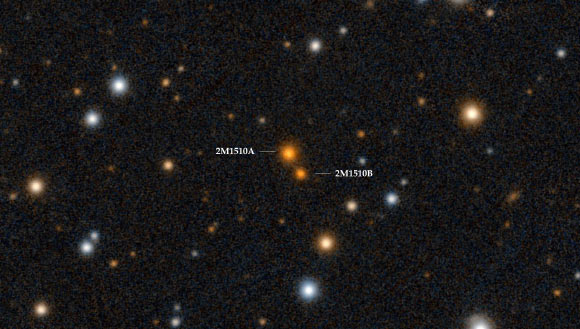Astronomers Spot Rare Eclipsing Brown-Dwarf Binary System | Astronomy – Sci-News.com
Astronomers using robotic telescopes at ESO’s newest planet-hunting SPECULOOS (Search for habitable Planets EClipsing ULtra-cOOl Stars) Observatory in Chile have spotted a very rare eclipsing brown dwarf binary in 2M1510, a triple system located 119 light-years away in the constellation of Libra. The detection of eclipsing brown dwarfs is extremely rare — only one other such system has been identified to date, 2MASS J05352184-0546085AB.

An artist’s rendering of two brown dwarfs. Image credit: Roberto Molar Candanosa & Sergio Dieterich, Carnegie Institution for Science.
“Among the first test observations we performed at SPECULOOS, we turned one of our telescopes to a known brown dwarf, 2MASSW J1510478-281817 (hereafter 2M1510A),” said SPECULOOS principal investigator Dr. Michaël Gillon, an astronomer at the Université de Liège.
“But suddenly the object appeared to get dimmer for about 90 minutes, which indicated an eclipse just took place.”
The observations picked up a distinct signal that led the astronomers to speculate that 2M1510 might be two brown dwarfs instead of one, in orbit around each other.
“We rapidly realized that we were probably looking at two eclipsing brown dwarfs, one passing in front of the other, a configuration which is much rarer than planetary systems,” said Dr. Artem Burdanov, a postdoctoral researcher at MIT.
The scientists were able to confirm their hypothesis using two more powerful telescopes: the 10-m Keck Telescope in Hawaii and the 8-m Very Large Telescope in Chile.
They detected the velocities of both brown dwarfs in 2M1510A as they orbit one another.
“From the very first spectrum we obtained, we could tell we had an exciting binary discovery,” said Professor Adam Burgasser, a researcher at the University of California, San Diego.
“It was thrilling to see the absorption lines move back and forth in perfect synchronicity, and this allowed us to measure the mass of the binary.”

This image shows the triple system 2M1510. Image credit: Centre de Données astronomiques de Strasbourg / SIMBAD / PanSTARRS.
The astronomers found that one member of the binary, 2M1510Aa, has a mass of 40 Jupiter masses and the other member, 2M1510Ab, has a mass of 39.3 Jupiter masses.
The brown dwarfs orbit each other once every 21 days and have a widely-separated brown dwarf companion, 2MASS J15104761-2818234 (2M1510B).
The scientists also found that the triple system is a member of the 45-million-year-old moving cluster of stars called the Argus moving group.
“Collecting a combination of mass, radius and age is really rare for a star, let alone a brown dwarf,” said Dr. Amaury Triaud, an astronomer at the University of Birmingham.
“Usually one or more of these measurements is missing. By drawing all these elements together, we were able to verify theoretical models for how brown dwarfs cool, models which are over 30 years old.”
“We found the models match remarkably well with the observations, a testament to human ingenuity.”
The team’s paper was published in the journal Nature Astronomy.
_____
A.H.M.J. Triaud et al. An eclipsing substellar binary in a young triple system discovered by SPECULOOS. Nat Astron, published online March 9, 2020; doi: 10.1038/s41550-020-1018-2






